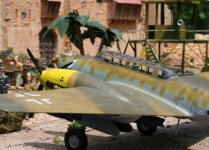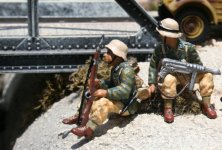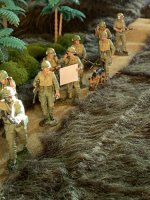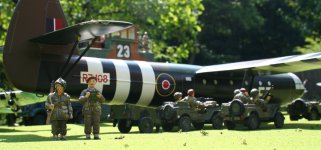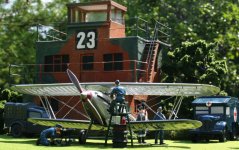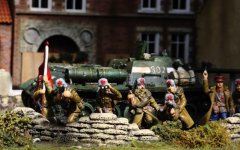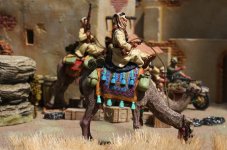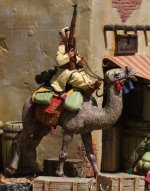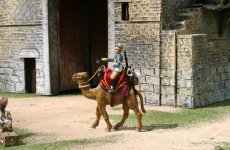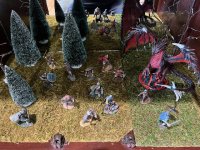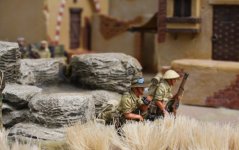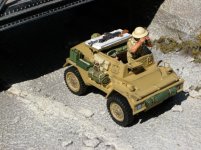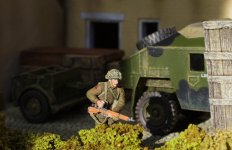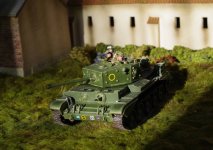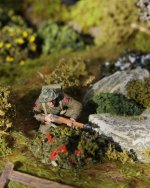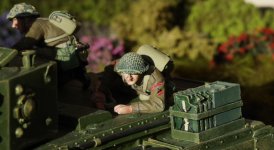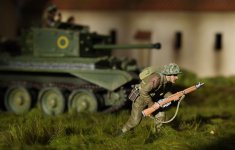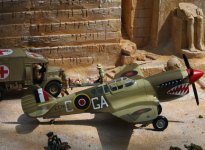
from Wikipedia .....
No. 112 Squadron was a squadron of the
Royal Air Force. It served in both the
First World War and
Second World War and was active for three periods during the
Cold War. It is nicknamed "The Shark Squadron", an allusion to the fact that it was the first unit from any Allied air force to use the famous "shark mouth" logo on
Curtiss P-40s.
[3]
First World War
The squadron was formed as No. 112 Squadron of the
Royal Flying Corps on 30 July 1917 at
Throwley Aerodrome,
Kent,
England for
air defence duties protecting the
London area. It was equipped initially with
Sopwith Pups and received
Sopwith Camels in 1918. One of its first commanding officers was Major
Quintin Brand (who would become a
group commander with
RAF Fighter Command during the
Battle of Britain). In the summer of 1918, the best pilots were selected to form
No. 151 Squadron which was sent to France. Still flying Camels they operated at night, attacking German airfields. Following the end of the war, the squadron was disbanded on 13 June 1919.
Second World War

A Flight Lieutenant standing by his Curtiss Kittyhawk Mk I at Sidi Heneish, Egypt, April 1942
The squadron was re-formed 16 May 1939, on board the aircraft carrier
HMS Argus for service in
Egypt. It was based initially at
RAF Helwan at
Helwan,
Cairo Governorate. On 26 May, "B" Flight was detached and sent to
Sudan. The squadron did not receive its aircraft, obsolescent
Gloster Gladiator biplane fighters, until June. After
Italy entered the war on 10 June 1940, the squadron was soon in action, defending Egypt from Italian bombers.
[4] "B" Flight became part of
No. 14 Squadron RAF on 30 June.
In January 1941, the squadron joined Allied forces in the
Battle of Greece, providing air cover and offensive support over
Albania. It later took part in dogfights as part of the air defence of the
Athens area. With the defeat of the Allied campaign on the Greek mainland, 112 Sqn withdrew to
Crete and then to Egypt, from where it rejoined the
North African Campaign, supporting the
Eighth Army. For much of the remainder of the war, the squadron was part of
No. 239 Wing, with
No. 3 Squadron RAAF,
No. 250 Squadron RAF,
No. 260 Squadron RAF and
No. 450 Squadron RAAF.
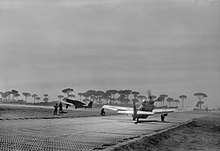
North American Mustangs of 112 Squadron loaded with 500-lb
GP bombs, taxi to the runway at
Cervia, Italy, before taking off in support of
Operation Olive the spring offensive in the
Po valley by the Eighth Army. A Mark III leads a Mark IV
During July 1941, the squadron was one of the first in the world to become operational with the
Curtiss Tomahawk, which it used as a fighter and
fighter-bomber. Inspired by the unusually large air inlet on the P-40, the squadron copied the "shark's mouth" logo painted on some German
Messerschmitt Bf 110s of
Zerstörergeschwader 76 earlier in the war. (This practice was later followed by P-40 units in other parts of the world, including the
Flying Tigers, American volunteers serving with the
Chinese Air Force.) In December, the Tomahawks were replaced by the improved P-40 Kittyhawk, which the squadron used for the remainder of its time with the
Desert Air Force, often as a
fighter bomber.
The squadron had many personnel from the air forces of
Poland,
Australia,
Canada and
New Zealand. Another member was the British
ace Neville Duke (later prominent as a
test pilot). For most of 1942, it was commanded by the highest-scoring Australian ace of World War II,
Clive Caldwell, the first
Empire Air Training Scheme graduate to command a British unit. He was succeeded by
Billy Drake, the highest-scoring RAF P-40 pilot and the second-highest-scoring British Commonwealth P-40 pilot, behind Caldwell. Later in the war, an increasing number of
South African pilots joined the unit.
After the
invasion of Sicily on 10 July 1943, the squadron moved to the island and onto the Italian mainland in September. In June 1944, the Kittyhawks were replaced by the
North American Mustang Mark III and from February 1945, Mustang Mk IVs. The squadron remained in Italy at
Lavariano as part of the occupying forces, until disbanding on 30 December 1946 at
Treviso. By the end of the war some 206 air victories had been claimed by the squadron and 62 destroyed on the ground.
[5]
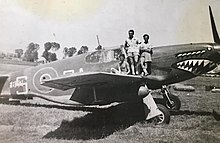
Cold War
The squadron re-formed at
RAF Fassberg in Germany on 12 May 1951, in the fighter bomber role, equipped with
de Havilland Vampire Mk 5s. It later moved to
Jever and then
RAF Bruggen. In January 1954 it assumed the
day fighter role, when its Vampires were replaced by
Canadair Sabre F Mk IVs.
Hawker Hunters were delivered to 112 Sqn in April 1956, but the unit was disbanded at Bruggen on 31 May 1957.
On 1 August 1960, the squadron was re-formed as a
Bloodhound surface-to-air missile unit, at
RAF Church Fenton, defending
Thor IRBM sites in the area. The squadron's operational base was at
RAF Breighton. Following withdrawal of the Thor from service, the need for the unit was reduced, and it disbanded on 31 March 1964.
However, 112 Sqn was re-formed on 2 November 1964, at
RAF Woodhall Spa, equipped with Bloodhound Mk 2s. The squadron moved to
Cyprus on 1 October 1967 and remained there until it was disbanded on 1 July 1975.
Aircraft operated

A restored P-40N painted in 112 Squadron RAF green livery (from 1943) taking off at
Temora, New South Wales


